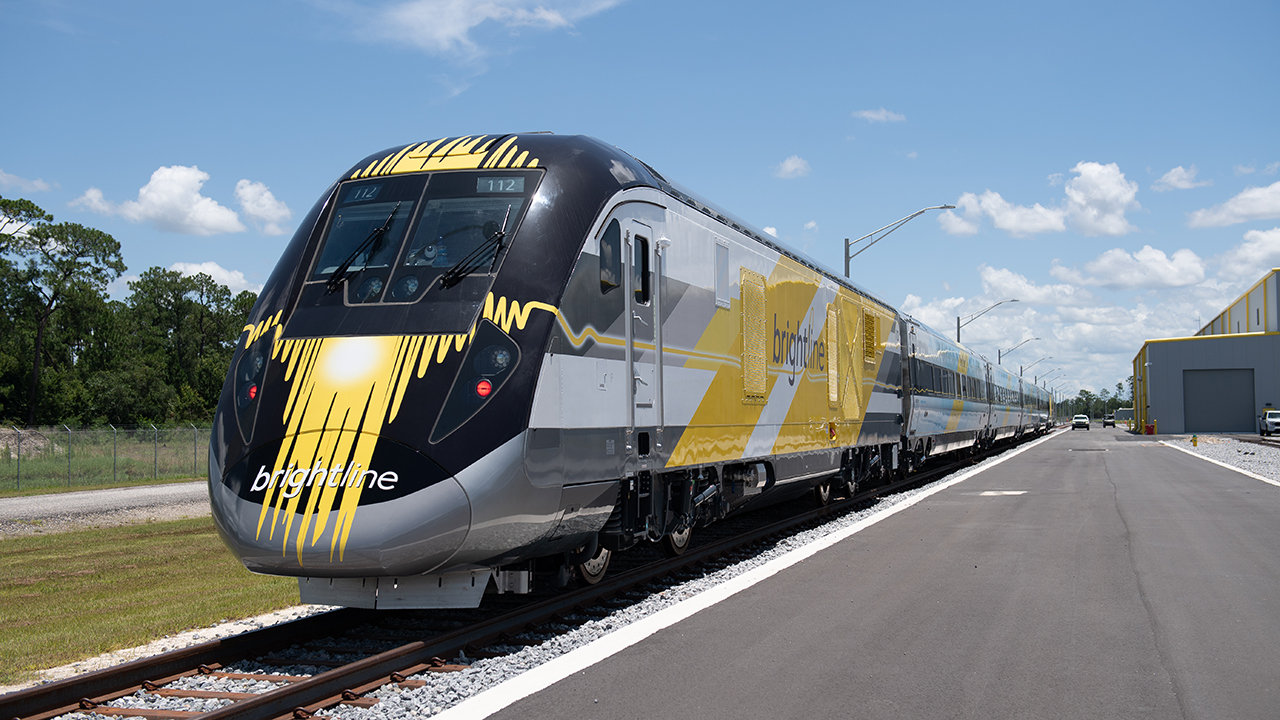
High-Speed Increase in Brightline Fares
Written by David Peter Alan, Contributing Editor
David C. Lester photo.
Until September 2023, Brightline, Florida’s private-sector passenger railroad, had only operated between Miami and West Palm Beach. Then, on Sept. 22, the railroad extended service to a new station at Orlando International Airport (MCO). That extension is now affecting fares on the original part of the railroad, as most commutation-style fares within South Florida will end soon. In effect, Brightline is transitioning from a railroad that has created a “luxury commute” in South Florida to one that is now concentrating on its corridor-length route to MCO, in the central part of the state.
Bye-Bye, Bargain!
A $399 pass between all South Florida stations, good for 40 rides over 30 days, will no longer be sold after May 31. Neither will an “all-station shared pass” that is good for travel to MCO. That will mark the end of $10 rides between Miami and West Palm Beach and intermediate stations, as well as $30 rides between MCO and all South Florida stops. According to Brightline, the only 40-ride monthly pass that will still be available will be “a limited number” of passes between Miami and Aventura (on the line between Miami-Dade and Broward Counties) for $299. With 40 rides available, that amounts to $7.50 per ride.
Brightline’s website, www.gobrightline.com, says: “These Aventura Commuter Passes remain due to a prior agreement between Brightline and Miami-Dade County.” A comparable ride on a local Miami-Dade Transit bus costs $2.25 (or $112.50 per month), but the trip is scheduled to take 75 to 90 minutes for most runs. I checked the Brightline booking site for a comparable trip at advertised fares on Thursday, May 23. The trip time is 17 minutes. Except for the 10:50 PM departure (the last train) from Miami, with a $9.75 fare, fares ranged from $15.60 to $31.85 (at 4:50 PM). The fares for most trains were $15.60, $18.85, or $23.35. “Premium class” fares are higher.
Mike Diamond reported on the change in the May 7 edition of the Palm Beach Post: “Brightline, unable to accommodate many of its Orlando passengers, is eliminating a popular $10-per-ride monthly pass program for South Florida commuters and has already begun reducing the number of seats available for purchase on short trips between Palm Beach, Broward and Miami-Dade counties … It is all part of a plan to help get as many passengers as possible on the longer and more profitable route to MCO, but it is coming at a higher cost to riders traveling within South Florida. Brightline spokesperson Ben Porritt told the Post that Brightline has always made it clear that its focus would be on the Orlando market.” I checked the Brightline website for a means to purchase a South Florida (SoFlo) pass, but could not find a means for doing so.
Brightline established a website, brightlinesupport.zendesk.com, with information about the change. It said, “In recent months, it has become increasingly difficult to accommodate all Guests as peak trains are reaching capacity. We continue to evaluate the best approach to balance demand, and as a result, the sale of Train Passes will be discontinued effective June 1, 2024.”
The doomed passes will be replaced by ten-trip tickets, which will be valid for 30 days. They will cost $250 between Miami and Fort Lauderdale, and $350 between Miami and West Palm Beach; 2.5 to 3.5 times the fare that soon will no longer be offered. Because it is in the private sector, Brightline is in a unique position to change fares as its managers see fit. This is a different situation than that faced by other regional passenger railroads, which are in the public sector, so they are subject to increased regulation. For example, New Jersey Transit is increasing fares on July 1 and imposing a 30-day limit on ticket use, which will end the policy of tickets being good until used. That agency was required to hold a set of hearings around the state. Riders and other advocates criticized the agency for those proposals, but they will be implemented anyway. Brightline is not required to go through similar steps.
Commuters Lose Option, Face Decision
The alternative railroad for South Florida riders is Tri-Rail, which has been providing local train service, especially at peak commuting hours, since 1989. Trains go as far as Mangonia Park, north of West Palm Beach, but running time is longer. The line is also several miles inland from the Florida East Coast (FEC) main, where Brightline runs. Tri-Rail opened a shuttle line from Brightline’s Miami Central Station to Metrorail Transfer earlier this year, and the Tri-Rail Board will vote soon on establishing express trains that will stop at Fort Lauderdale, Boca Raton and West Palm Beach, stops roughly due west of Brightline, but by several miles.
On May 7, Dylan Huberman, reported for WPEC in West Palm Beach with a story headlined Brightline doing away with monthly commuter passes, derailing riders’ plans to get to work: “Commuters who rely on it for work say they feel betrayed.” He quoted Jeff Lewis, who lives in Fort Lauderdale, but works in West Palm Beach, as saying, “When I bought the condo, the biggest part of purchasing the condo was to be right by the Brightline station, so life decisions were made. So now it’s back on I-95 and we’ll see. … It sucks. You plan your life around something and then, it’s just taken away.”
In Railway Age’s reporting on Brightline over the years, we noted that the railroad was promoting transit-oriented development (TOD) near its stations, for people who believe that having a useful rail line nearby makes a location desirable. Now, it can be argued that Brightline has reversed that policy.
A Brightline spokesperson told Railway Age, “Brightline has been built to connect Central and South Florida, and along the way we’ve transformed how people get around South Florida. We’ve proven there is market demand for additional commuter options, and we need the public sector to step up provide additional routes and services. We’re currently negotiating with Broward and Miami Dade for a future commuter system and engaged with Tri-Rail for an express service that could come on line in short order.”
According to a report from April 30 in Miami Today, plans call only for a single round trip express that would run at peak commuting time. The report also quoted Tri-Rail Executive Director David Dech as saying that one-seat service on all trains to and from Miami Central is three years in the future.
We recently reported on Brightline’s projected ridership numbers, and they appear to reflect a capacity problem for the railroad with currently available equipment. Brightline’s consists include four cars, three SMART Class coaches and one Premium Class car, with a Siemens Charger locomotive at each end. There are more Siemens cars on order, which would increase the consists to six passenger cars, but that still means a limited number of seats to accommodate anticipated rider demand. Brightline has apparently made a business decision to emphasize travel between the South Florida and Orlando regions, after upgrading part of the FEC main for higher-speed, 110-mph running and constructing a purpose-built, dedicated 125-mph segment.
What About Local Service?
We have reported on proposals to increase local rail service in South Florida, including for commuters, before. Brightline is planning to run local service between Miami Central and Aventura. Tri-Rail is already running from Miami Central Station, but most riders from there will have a two-seat ride for some time to come, even though there are timed connections at Metrorail Transfer, which has historically been a connection point between Tri-Rail and Metrorail, Miami’s elevated rapid transit line.
There have also been proposals for turning the FEC main, where Brightline operates, into an additional local line. It would run parallel to the existing Tri-Rail line, but east of it, which would provide more-convenient locations through the more-heavily populated strip of the region than Tri-Rail does. That includes downtown areas in places like Hollywood and Fort Lauderdale. The issue there is how to schedule so many trains on the line, made more difficult because Brightline trains make only three intermediate stops between Miami and West Palm Beach. Currently, Brightline is running hourly throughout its service day. There is also FEC freight. There has been talk of Amtrak using the line, although Amtrak only runs two daily round trips in Florida currently. Can the line also accommodate what would probably become a popular regional service, as well?
I don’t know, and neither do I know what capital improvements will be needed before there would be sufficient capacity to accommodate local service of this sort. I also don’t know if the State of Florida would be willing to help pay for any such improvements, given the realities of the state’s politics today. The same question could be posed to Miami-Dade, Broward and Palm Beach Counties, the three counties where the prospective riders live, and which originally founded Tri-Rail.
When I rode Brightline from end to end on April 4, I took a round trip on an afternoon train from MCO to Miami and on the last train of the evening back to MCO. Many of the riders on that evening train got off at Fort Lauderdale, and only a few stayed on past West Palm Beach to go all the way. Admittedly, this is anecdotal evidence, but it could indicate that Brightline ended up establishing a “luxury commuting” market, whether or not the railroad had intended that result. Now, faced with limited capacity and anticipated strong growth in ridership to and from its new station at MCO, Brightline is concentrating on that route, which apparently includes reducing demand for local rides to keep more seats available for MCO riders.
So how would a burgeoning market for commuting and other local train service in Florida be served, if that even happens at all? As Brightline indicated, that will be up to the public sector, although it is reasonable to expect that Brightline’s participation would be needed to provide any service expansion on the line it uses. Time will tell if this happens, and we will report any significant new developments.

David Peter Alan is one of North America’s most experienced transit users and advocates, having ridden every rail transit line in the U.S., and most Canadian systems. He has also ridden the entire Amtrak and VIA Rail network. His advocacy on the national scene focuses on the Rail Users’ Network (RUN), where he has been a Board member since 2005. Locally in New Jersey, he served as Chair of the Lackawanna Coalition for 21 years and remains a member. He is also Chair of NJ Transit’s Senior Citizens and Disabled Residents Transportation Advisory Committee (SCDRTAC). When not writing or traveling, he practices law in the fields of Intellectual Property (Patents, Trademarks and Copyright) and business law. Opinions expressed here are his own.



